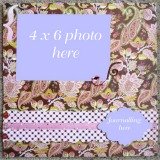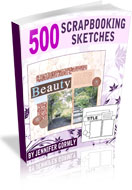Scrapbook Photographs
Scrapbooking is a wonderful way to preserve memories, experiences, and stories through photos, artifacts, and written words.
And scrapbook photographs are the soul of a scrapbook, so it's important to handle, organize, and display them correctly.
Scrapbooks are made of photographs and journaling. Even the most disinterested reader of your scrapbook will glance at the pictures.
As the saying goes, pictures really are worth a thousand words. Therefore, it is important to choose pictures that are of good quality and clearly illustrate your scrapbook theme.
Any photo can be used in a scrapbook. Even instant photograghs can be used in scrapbooking. Just be careful that the chemicals within the photograph do not spill out on the rest of your scrapbook, so it is important that you print your pictures on lignin free paper or cards.
with the advent of digital software and apps, it has become very easy and simple, to take, crop, distribute photos, moreover it can easily be printed right onto lignin-free and acid-free paper.
Always keep in mind that Scrapbooks is to preserve memories. Therefore, it is probably preferable to use copies of your only picture. Simply scan or take a Picture with your phone and print the image on lignin free and acid free paper.
Basics Of Scrapbook Photographs
Here are some of the most common basics and the finer details of scrapbooking photographs.
1. Photo Selection:
Begin by choosing the photographs you want to include in your scrapbook. Select pictures that narrate a story or provoke emotions, focusing particularly on high-quality ones. It's essential to choose photos that accurately depict the events or memories you're trying to capture.
2. Safe Handling:
Use clean hands when handling photos and only touch the edges to avoid damaging them with oils or dirt from your fingers. Use acid-free gloves if necessary.
3. Sorting Photos:
Organize your photographs in a logical manner – it could be chronological, thematic, or according to people, places, etc. This will ease the process of creating the scrapbook.
4. Scanning and Printing:
If you have old photos that you want to preserve, scan them to create digital copies. You can also print digital photos on high-quality photo paper.
5. Photos Back-up:
Always keep a back-up of your photographs. If you’re using original photos, scan them to create digital copies; if they're digital to start with, save them to an external hard drive or cloud storage.
6. Scrapbook Layout:
Decide on a layout for your scrapbook. You can stick to a uniform layout throughout, or mix and match according to the photos, themes, or stories.
7. Photo Placement:
Your photos should be the center of attention. Arrange them in a way that they narrate a story or create a visual path. You might want to add other memorabilia such as tickets, maps, or cards, which can add a nice touch, but make sure they don't overshadow your photos.
8. Photo Editing:
Do some basic editing, if necessary, to enhance the visual appeal – crop off unnecessary parts, adjust lighting, colors, etc. Use software programs for this, but avoid making drastic alterations.
9. Photo Journaling:
Adding descriptions, captions, or short stories related to the photos can give them context. It can be as simple as the date and place, or more explanatory, giving background information about the photo.
10. Preservation:
Use acid-free, lignin-free, and PVC-free products to ensure your photos don't deteriorate over time. Many products used in scrapbooking (papers, adhesives, etc) are specially designed for long-lasting preservation.
11. Non-Damaging Adhesives:
Use photo-safe adhesives to stick your photos in the scrapbook. These include photo corners, water-based glues, double-sided tabbing tape, and photo-hinging tape. Avoid rubber cement and regular tape.
12. Photo Templates:
Use different sized photo templates to add variety to your scrapbook. These templates can also be used to crop your photos into different shapes like circles, ovals, squares, etc.
13. Mats and Borders:
Use mats and borders to highlight your photos. This not only adds aesthetic appeal but also provides protection as the photo doesn't touch the page. Matting allows the focal point to stand out and provides a space for journaling.
14. Embellishments:
Add embellishments to complement your photos. They might include ribbons, stickers, stamps, or even hand-drawn doodles. But don't go overboard – the photos should remain the main focus.
15. Review and Revise:
Continually review your work as you design the scrapbook, ensuring that everything is placed and spaced as individual elements, yet they come together as a whole harmoniously.
16. Storage:
When you've completed your scrapbook, store it in a cool, dry place away from light. Acid-free storage boxes are a good option.
Remember, scrapbooking is a hobby that should be enjoyable. Feel free to exercise your creativity and make your scrapbook as unique as the memories it holds. Hope this guide helps you to create a phenomenal scrapbook with your photographs! Happy scrapbooking!
Remember scrapbooking ideas is limited only to your own imagination. We are all unique and have different lives, careers, hobbies, experiences etc from others.
Capitalize on your uniqueness and turn it into your own unique scrapbooking pages.
Subscribe To Newsletter
All scrappy ideas
It keeps you informed about unique themed scrapbooking ideas, free layouts, Product reviews, supplies, tips, information etc.
Or you can even share your ideas, suggestions feedback etc that will help us improve our scrapbooking experience.
Scrapbook Contest
Win Huge Prizes participate in our Scrapbook Contest, It's easy and fun.
Related Pages
Affiliated Links



















